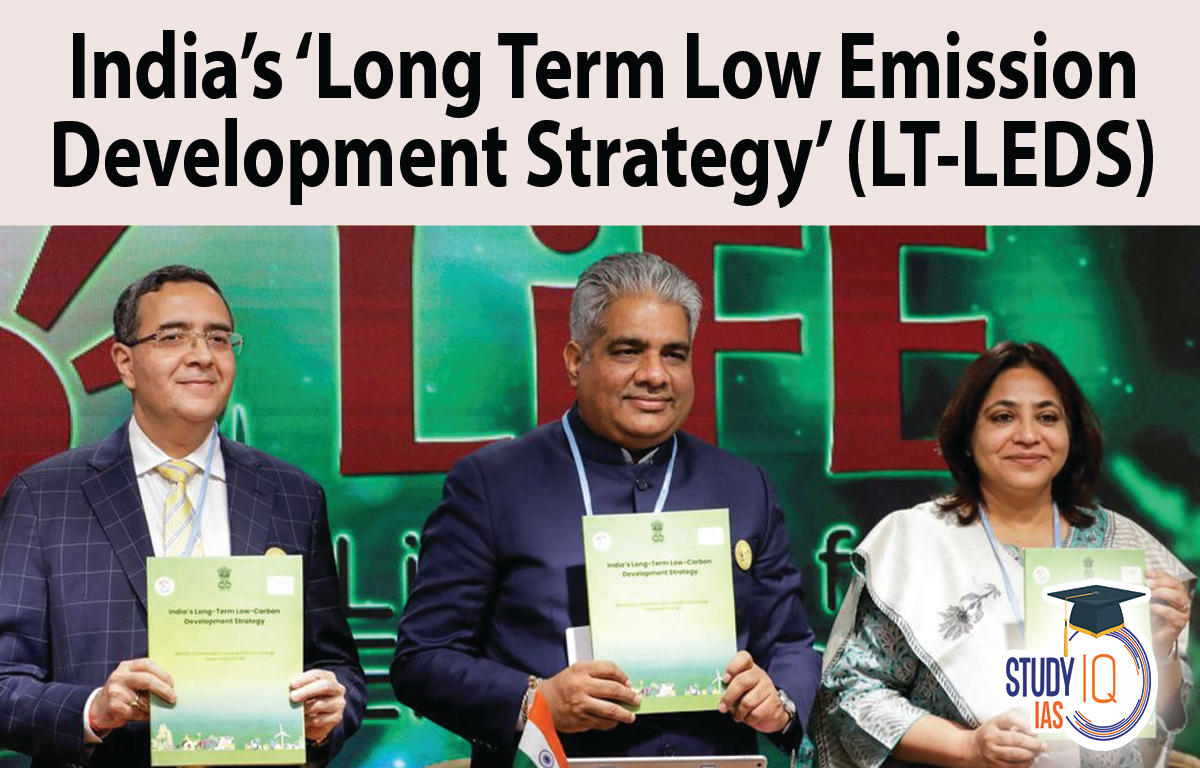Table of Contents
Long Term Low Emission Development Strategy News
- It came a year after the Prime Minister announced India’s net-zero target by 2070 as part of the ambitious “Panchamrit” pledge at the COP26, Glasgow.
- With this release, India joins the select list of less than 60 parties that have submitted their long-term strategies to the UNFCCC.
- The strategy has been prepared after extensive consultations held by Ministry of Environment, Forest and Climate Change with all relevant Ministries and Departments, State Governments, research institutions, and civil society organizations.
Long Term Low Emission Development Strategy Background
- Paris Agreement: Under the 2015 Paris Agreement, countries have to prepare and submit two kinds of climate action plans — one for the short term, and another for long-term.
- The short-term climate action plans: Also called Nationally Determined Contributions (NDCs), have to be submitted every five years, with specific actions being taken over 5- or 10-year periods. The NDCs of all countries currently contain the actions they are taking till 2030.
- In September 2022,India updated its NDCs to UNFCCC, under which India has promised three main targets for 2030:
- 45 per cent reduction in emission intensity (emission per unit of GDP) from 2005 levels.
- 50 per cent share of renewables in electricity generation.
- Creation of 2.5 to 3 billion tonnes of additional carbon sink through forests.
- The long-term climate action plans: Apart from NDCs, the Paris Agreement also asks countries to submit their long-term strategies to reduce emissions.
- There is no particular time frame for which these long-term strategies have to be prepared, but it is generally understood that countries will draw out plans till the middle of the century.
Long Term Low Emission Development Strategy Highlights
- India’s approach to low-carbon development: India’s approach is based on the following four key considerations that underpin its long-term low-carbon development strategy:

- Seven key focus areas of India’s LT-LEDS: India’s LT-LEDS rests on seven key transitions to low-carbon development pathways.
Energy Sector
w-carbon development pathways for the energy sector:
- Expanding renewables and strengthening the grid
- Exploring and/or supporting other low carbon technologies
- Focusing on demand-side management
- Rational utilization of fossil fuel resources, with due regard to energy security
- Determining green taxonomy and optimum energy mix
Transportation Sector
Low-carbon options for the transportation sector:
- Encouraging improved fuel efficiency
- Phased transition to cleaner fuels
- Modal shift towards public and less polluting modes of transport
- Electrification across multiple transport modes
- Demand side management
- Traffic management and intelligent transport systems
Urban Design
Pathways for sustainable urbanization:
- Mainstreaming adaptation measures in the built environment and urban systems
- Promote resource efficiency within urban planning guidelines, policies, and bylaws
- Promote climate responsive and resilient building design, construction, and operation in existing and future buildings and in urban systems
- Promote low-carbon municipal service delivery through resource efficiency, management of water, solid, and liquid waste
Industrial Sector
Decoupling of industrial growth from carbon emissions:
- Improve energy and resource efficiency, with efforts to increase the use of natural and bio-based materials
- Process and fuel switching and electrification in manufacturing, as feasible and viable
- Enhance material efficiency and recycling, strengthening the circular economy
- Promote green hydrogen technology and infrastructure
- Explore options for sustainable growth of hard-to-abate sectors
- Low carbon and sustainable growth of MSMEs
Carbon Capture Utilization and Storage (CCUS) Technologies
- This is a new sector being explored world over and may also be explored in the Indian context.
- This shall require substantial international support through innovation, technology transfer, climate-specific finance and capacity building.
Enhancing Forest and Vegetation Cover
Elements of long-term low emission development includes:
- Restoration, conservation, and management of forests and their plant, animal and microbial genetic resources
- Restoration, conservation, and management of trees outside forests
- Strengthening infrastructure of State forest departments, including upgradation of nurseries
Economic and financial aspects of low-carbon development
Given our national priorities for development, low-cost international climate finance is essential to achieve the objectives of low carbon development. In this regard the focus areas include:
- Mainstreaming of climate-specific finance, especially multilateral climate finance
- Technology transfer, capacity building and linkages to international trade
- New multilateral mechanisms for supporting innovation, and technology development
Long Term Low Emission Development Strategy Announcements by India
- Nuclear energy: India is set to expand its nuclear power capacity by at least three-fold in the next decade.
- Green hydrogen: India aims for becoming an international hub for producing green hydrogen through the National Hydrogen Mission.
- Ethanol blending: India aspires to achieve ethanol blending of 20% by 2025 (it is currently 10%).
- Energy efficiency: India will also focus on improving energy efficiency by the Perform, Achieve and Trade (PAT) scheme.
























 WhatsApp
WhatsApp